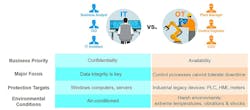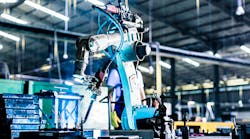Why Smart Manufacturing Initiatives Often Fall Short of Expectations
On the mind of every manufacturing leader is how to build data-driven smart factories as quickly as possible.
The value of creating a smart factory is undeniable: increased efficiency, cost reduction, scalable operations, and better risk management are just a few of the benefits that await. As a result, many manufacturers have started their digital transformation journey.
That said, research has shown that even after years of implementing smart factory initiatives, over 85% of companies are unable to achieve successful deployments.
According to Moxa, a supplier of industrial networking solutions, one of the major obstacles holding them back is IT/OT convergence.
IT (Information Technology) units and OT (Operational Technology) units have traditionally run in parallel.
During daily factory operations, the IT team manages a spectrum of business applications supporting the order-to-shipment process. The OT team is responsible for ensuring that back-end operations run smoothly, from material procurement and production to warehousing.
These two teams rarely work together, and do so only to handle specific issues that come up like network disconnection, data loss, or a security breach. Dealing with these situations alone could leave them completely spent.
Today, smart manufacturing has broken down the silos between information and production. These two teams that worked in parallel must now converge in order to create new capabilities for the company. They even share the same objectives and goals, such as building flexible supply chains, optimizing capacity utilization, and minimizing downtime through predictive maintenance.
These innovative approaches will bear fruit only when IT and OT experience and expertise are combined. From our experience as a frontrunner in IT/OT convergence and enabling clients to succeed with their digital transformation, we identified the top three barriers to achieving IT/OT collaboration in smart manufacturing projects.
1. Different Focus on Data
The first step toward smart manufacturing is data collection. However, the IT team, which is responsible for analyzing data, does not know exactly what data should be collected due to a lack of understanding of factory operations.
On the other hand, the OT team, whose priority is ensuring smooth production, may not be able to collect enough data for IT to analyze. Making matters worse, OT equipment frequently uses proprietary protocols that come from their respective vendors. The number of protocols used in a medium-size factory can easily reach double-digits, further complicating data collection.
This is why the first step toward smart manufacturing is usually the hardest one.
An experienced project leader must ensure that IT and OT personnel engage in all the discussions in the early stages, so that data acquisition and data analysis needs can be aligned.
A more aggressive method is to set up a new department from scratch, such as a new information unit under the manufacturing group, to ensure that IT and OT teams share the same objective and operate as a single team.
2. Different System Development Methodologies
For IT professionals, system architecture planning is key. They design and develop custom systems based on user requirements, which must be clearly specified beforehand. Repeated changes and tweaks during the design process are resisted.
In contrast, to ensure the interoperability and reliability of various systems running in unison, OT experts are used to adopting modular design methods, conducting pilot runs, and adjusting modules based on test results.
Inevitably, the test-and-adjust tactic can result in increased user demands. The IT team is then tasked with repeatedly changing the system design to meet the new requirements, often leading to friction between the two teams.
The “on-the-fly” development methodology presents a new challenge for IT professionals. If OT experts keep their IT colleagues informed of the system testing methods and potential adjustments before development work starts, they can ensure the IT team is better prepared to tackle the various changes that will happen during the development phase and ensure the project’s success.
3. Different System Maintenance Requirements
After all the blood, sweat, and tears going into deploying the system, collaborating on system administration and maintenance bring yet another challenge.
To any trained IT professional, every issue must be resolved immediately because a tiny problem could turn into a disaster over time. However, the manufacturing industry requires continuous, undisrupted production is critical to remain competitive.
Rather than addressing minor issues right away, OT professionals choose to fix them when—and only when—the production line is not running. Before implementing any changes or upgrades, they would also meticulously test everything to avoid negatively affecting production. Otherwise, they would prefer to continue with the existing process, albeit with a few flaws.
One way to look at things is to see IT personnel like smartphone users. They are accustomed to (and even looking forward to) frequent software updates, as well as the new system functions, enhancements, and fixes that come with updates.
On the other hand, OT-oriented personnel are more akin to train operators. They are extremely prudent about any changes to the system or to procedures. They are risk-averse because, without extensive testing, small changes could cause unexpected issues that could escalate into a full-blown crisis.
Therefore, right from the beginning when designing the system, IT and OT teams must clearly communicate and closely align how they expect system maintenance to be performed.
To unlock the true power of digital manufacturing, it takes more than just converting production data into flashy reports accessible on mobile devices, or the simple purchase of robotic arms or faster automation systems. It takes true collaboration to deliver on the promise of the smart factory and make its benefits real.
To achieve this, manufacturers need to start off on the right foot, fostering mutual understanding between IT and OT professionals. By forging teams with converged IT/OT competence and experience, manufacturers can create the foundation they need to succeed with their digital transformation.
















